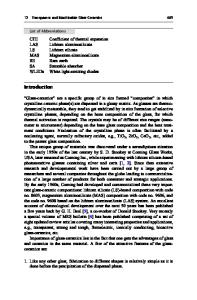XANES studies on Eu-doped fluorozirconate based glass ceramics
- PDF / 366,360 Bytes
- 6 Pages / 612 x 792 pts (letter) Page_size
- 30 Downloads / 280 Views
1262-W08-03
XANES studies on Eu-doped fluorozirconate based glass ceramics Bastian Henke1,2, Patrick Keil3, Christian Paßlick2, Dirk Vogel3, Michael Rohwerder3, MarieChristin Wiegand4, Jacqueline A. Johnson5, and Stefan Schweizer1,2 1 Fraunhofer Center for Silicon Photovoltaics, Walter-Hülse-Str. 1, 06120 Halle (Saale), Germany 2 Centre for Innovation Competence SiLi-nano, Martin Luther University of Halle-Wittenberg, Karl-Freiherr-von-Fritsch-Str. 3, 06120 Halle (Saale), Germany 3 Department of Interface Chemistry and Surface Engineering, Max-Planck-Institut für Eisenforschung GmbH, Max-Planck-Str. 1, 40237 Düsseldorf, Germany 4 Department of Physics, University of Paderborn, Warburger Str. 100, 33100 Paderborn, Germany 5 Department of Materials Science and Engineering, University of Tennessee Space Institute, Tullahoma, TN 37388, USA
ABSTRACT The influence of adding InF3 as a reducing agent on the oxidation state of Eu in fluorochloro- (FCZ) and fluorobromozirconate (FBZ) glass ceramics was investigated using x-ray absorption near edge (XANES) and photoluminescence (PL) spectroscopy. For both materials, it was found that InF3 decreases the Eu2+-to-Eu3+ ratio significantly. PL spectroscopy proved that an annealing step leads to the formation of Eu-doped BaCl2 and BaBr2 nanocrystals in the FCZ and FBZ glasses, respectively. In the case of FCZ glass ceramics the hexagonal phase of BaCl2 could be detected in indium-free and InF3-doped ceramics, but only for InF3 containing FCZ glass ceramics a phase transition of the nanoparticles from hexagonal to orthorhombic structure is observed. For the FBZ glass ceramics, the hexagonal phase of BaBr2 can be formed with and without indium doping, but only in the indium-free case a phase transition to orthorhombic BaBr2 could be found. INTRODUCTION A class of fluorochloro- (FCZ) and fluorobromozirconate (FBZ) glass ceramics has been developed for ionizing radiation detection. The composition of these materials is derived from a standard ZBLAN glass, i.e. a fluoride glass, made from Zr, Ba, La, Al, and Na fluorides. Several synthesis routes have been derived to maintain Zr in the 4+ state where the addition of a small amount of InF3 plays a key role in the glass production process. The glasses under investigation were additionally doped with Cl or Br ions by partial substitution of the fluorides BaF2 and NaF for BaX2 and NaX (X = Cl, Br), respectively. This enabled precipitation of BaX2 nanocrystals within the glass upon appropriate annealing. For ionizing radiation detection, Eu is added to the glass for optical activation. Depending on the structural phase of the BaX2, the glass-ceramic material can act either as a scintillator (able to convert ionizing radiation to visible light), or as a storage phosphor (able to convert the radiation into stable electron-hole pairs, which can be released at a later time with a scanning laser beam).
Figure 1. Normalized XANES spectra of the as-made, indium-free, Eu-doped FBZ glass. A pseudo-Voigt function (dashed curve) and an arctan funct
Data Loading...











